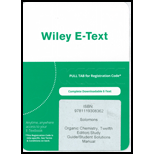
ORGANIC CHEMISTRY-ETEXT REG ACCESS
12th Edition
ISBN: 9781119308362
Author: Solomons
Publisher: WILEY
expand_more
expand_more
format_list_bulleted
Question
Chapter 24, Problem 11PP
Interpretation Introduction
Interpretation:
The classes of reactions are involved in the cleavage of the Fmoc group with piperidine,
leading to the unprotected amino acid and the fluorene byproduct are to be determined. The mechanisms for these reactions are to be written.
Concept introduction:
The 9-fluorenylmethyloxycarbonyl protecting group (Fmoc) is a protecting group particularly used in peptide chemistry. It protects the amino group of the first amino acid. It is stable under low pH, but can be removed under high pH. The solution of 20% piperidine in DMF is usually employed.
Expert Solution & Answer
Want to see the full answer?
Check out a sample textbook solution
Students have asked these similar questions
tert-Butoxycarbonyl azide was developed as a reagent for peptide synthesis at OWL's home institution, the University of Massachusetts, by Prof. L.A. Carpino. It is prepared by treating tert-butoxycarbonyl chloride with sodium azide. Propose a structure for the initially-formed intermediate in this reaction.
26. (i) Why is the ester formation of alcohols and acid chlorides done in a
weakly basic solution like pyrmidine? (ii) Why is this setup not viable for
alcohols and carboxylic acids to form esters?
pyrimidine deprotonates the alcohol; the alkoxide ion forms
pyrimidine deprotonates the alcohol; the carboxylate ion forms
pyrimidine deprotonates the tetrahedral intermediate; the alkoxide ion forms
pyrimidine deprotonates the tetrahedral intermediate; the carboxylate ion forms
The reaction of ninhydrin with an -amino acid occurs in several steps
(a) The first step is loss of water to give a triketone. Show the mechanism of the reaction and the structure of the triketone.(b) The second step is formation of an imine by reaction of the amino acid with the triketone. Show its structure. (c) The third step is a decarboxylation. Show the structure of the product and the mechanism of the decarboxylation reaction.
(d) The fourth step is hydrolysis of an imine to yield an amine and an aldehyde. Show the
structures of both products.
(e) The final step is formation of the purple anion. Show the mechanism of the reaction
Chapter 24 Solutions
ORGANIC CHEMISTRY-ETEXT REG ACCESS
Ch. 24 - Prob. 1PPCh. 24 - Practice Problem 24.2 The guanidino group NHNHCNH2...Ch. 24 - Prob. 3PPCh. 24 - Prob. 4PPCh. 24 - Prob. 5PPCh. 24 - Prob. 6PPCh. 24 - Prob. 7PPCh. 24 - Practice Problem 24.8
Glutathione is a tripeptide...Ch. 24 - Prob. 9PPCh. 24 - Prob. 10PP
Ch. 24 - Prob. 11PPCh. 24 - Practice Problem 24.12 Show all steps in the...Ch. 24 - Practice Problem 24.13 The synthesis of a...Ch. 24 - Practice Problem 24.14
The terminal carboxyl...Ch. 24 - Prob. 15PPCh. 24 - Prob. 16PPCh. 24 - (a) Which amino acids in Table 24.1 have more than...Ch. 24 - Prob. 18PCh. 24 - 24.19 (a) On the basis of the following sequence...Ch. 24 - Prob. 20PCh. 24 - Prob. 21PCh. 24 - Prob. 22PCh. 24 - Prob. 23PCh. 24 - Prob. 24PCh. 24 - The enzyme lysozyme and its mechanism are...Ch. 24 - Prob. 2LGP
Knowledge Booster
Similar questions
- 4(a) Suggest a test you will use to show that a given food substance contains protein.(b)Show how you will use(i)Modified Gabriel’s Synthsis(ii)Streckers’s Synthesis to prepare phenylalanine in the laboratory.arrow_forwarda) Explain why the acetamido group is an ortho, para-directing group. Why should it be less effective in activating the aromatic ring toward further substitution than an amino group? b) o-Nitroaniline is more soluble in ethanol than p-nitroaniline. Propose a flow scheme by which a pure sample of o-nitroaniline might be obtained from this reaction.arrow_forwardWrite a structural formula for the product formed by treatment of the N-terminal amino group with Sanger’s reagent and propose a mechanism for its formation.arrow_forward
- can some please draw and explain in detail the reaction mechanism BENZIMIDAZOLES from o-phenylenediamine and formic) acid and hippuric acid from glycine and benzoyl chloridearrow_forwardShow how the Gabriel malonic ester synthesis could be used to prepare: (a) valine (b) phenylalanine (c) glutamic acid (d) leucinearrow_forwardSynthesize octadecyl stearate using linoleic acid (18:2) (Given, stearic acid: 18:0) as the only starting material.arrow_forward
- -Amino acids can be prepared by the Strecker synthesis, a two-step process in which an aldehyde is treated with ammonium cyanide followed by hydrolysis of the amino nitrile intermediate with aqueous acid. Propose a mechanism for the reaction.arrow_forwardSuggest a test you will use to show that a given food substance contains protein. Show how you will use; A modified Gabriel's synthesis A Streckers' synthesis to prepare phenylalanine in the laboratory.arrow_forwardUsing reaction equations, discuss the solubility of prilocaine in:a) Acidic aqueous environment b) Alkaline aqueous environment c) Chloroform5. Write down the reaction mechanism for acid amide hydrolysis of prilocaine.arrow_forward
- Synthesize the compund (Nimodipine) via Hantzsch dihydropyridine synthesisarrow_forwardOn the basis of the general mechanism for amide hydrolysis in acidic solution shown in Mechanism 20.4, write an analogous sequence of steps for the hydrolysis of acetanilide.arrow_forwardWhy is retrosynthesis seen as a very important approach in the synthesis of organic compounds, explain the steps in retrosynthesis and apply them in the synthesis of p-amino benzoate analgesics. Why is a protective group needed in the synthesis stage ?arrow_forward
arrow_back_ios
SEE MORE QUESTIONS
arrow_forward_ios
Recommended textbooks for you
